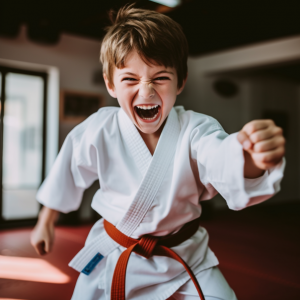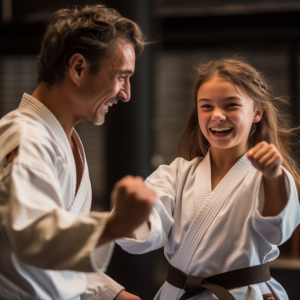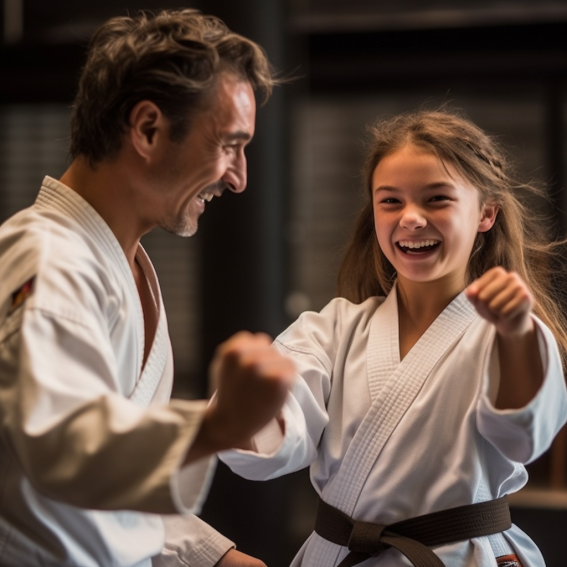 The popularity of martial arts within the Western World has grown significantly in the last few decades. Specifically in the United States, between 2010 and 2021 the total number of people practicing this sport went up to around 6.2 million (Statista, 2022). According to the Australian Bureau of Statistics (2009), martial arts are among the ten most practiced sports among children and adolescents in parts of North America and several European countries.
The popularity of martial arts within the Western World has grown significantly in the last few decades. Specifically in the United States, between 2010 and 2021 the total number of people practicing this sport went up to around 6.2 million (Statista, 2022). According to the Australian Bureau of Statistics (2009), martial arts are among the ten most practiced sports among children and adolescents in parts of North America and several European countries.
Even more exciting, martial arts has grown in popularity in the Autism Spectrum Disorder community. Autism is the second most common developmental disability in the United States, and its prevalence is rising (Therapeutic Recreation Journal, 2016). While many parents of children with autism have experienced the benefits of martial arts training firsthand, some remain hesitant.
Unfortunately, to the untrained eye, the most widely held beliefs about martial arts are contrived from the media and the entertainment industry – not from a factual standpoint. These misconceptions can place martial arts in a broadened category of “violent” sports and may cause some parents to shy away from enrolling their children (Vertonghen & Theeboom, 2010).
Research shows quite the opposite is true when discussing the inherent belief system and points of reverence, specifically within the realm of karate and its differing styles. The education process of learning any martial art is far more comprehensive than what most individuals see in a Hollywood blockbuster (which usually highlights the brutality because it equates to “shock value”). The entertainment industry has truly done a great disservice by diminishing the core values of martial arts, and by not highlighting the factual origins and potential benefits of learning each style.
Basic Concerns
Parents of children who grapple with cognitive disabilities like autism approach the idea of enrolling them in a sport seen as “aggressive” with caution. Autistic children often display a tendency to lash out physically, either by kicking or striking authority figures due to frustration. Their challenges in coordinating movements and exercising functional control make the prospect of them acquiring skills that could potentially be harmful to others quite worrisome for the parents.
However, we must contrast these concerns with the long-term improvements that are seen in children with these challenges which far outweigh any misconceptions of violence or misuse of physical strength. In fact, in a study where autistic children were enrolled in a local martial arts program, the results that were found were phenomenal. This study published by the National Library of Medicine (2022) stated,
“The children … showed more cooperative behaviors and increased communication, allowing them to gradually improve behaviors that were difficult to adapt to in real life. The evaluation score after two years of training was higher than the evaluation score after one year of training. This showed that, after comprehensive intervention and long-term training of martial arts routines, children’s various abilities have been improved, and the degree of improvement is increased with the extension of training time, fully illustrating the necessity of applying martial arts routines to autism intervention” (Steyn & Rowe, 2009).
While this may seem a surprise to some, those who have trained for a length of time recognize how martial arts can benefit anyone – especially those with movement and developmental disorders.
 Let’s look at another study that was done specifically with children who suffer from autism and how martial arts training positively affected their abilities:
Let’s look at another study that was done specifically with children who suffer from autism and how martial arts training positively affected their abilities:
Two researchers from the University of California Irvine performed an intervention study involving martial arts training with a group of school-aged (8-11-year-olds) children with diagnosed autism spectrum disorder. This study was published in the Journal of Autism and Developmental Disorders. The training consisted of 26 forty-five-minute classes over 13 weeks. Technical training was adapted to the needs of each participant and was given in a “traditional” format, meaning an “emphasis on character development and self-control in addition to physical training.” (Phung & Goldberg, 2019).
“After the training, the children had improved executive function compared to a wait-list control. In particular, the training enhanced behavior and emotional regulation. This rigorous study provides compelling additional evidence that those on the autism spectrum can benefit significantly from carefully applied martial arts training that includes an emphasis on physical, philosophical, and behavioral development” (Phung & Goldberg, 2019).
It’s also important to note that the primary focus of martial arts is not the level of physical combat that can be achieved, but rather the self-control and discipline aspects, to name a few. Karate is rooted in the concept of respect, restraint, and responsibility according to the “20 Precepts of Karate” written by Master Gichin Funakoshi in 1938, widely considered to be the “Father of Modern Karate” (Funakoshi, 1938). The ultimate goal is to teach these concepts to students while remaining in a state of relaxed alertness, or zanshin.
Of course, self-defense is a focus. However, knowledge of self-defense comes after self-control and the learning process is pointed and methodical – especially with children who are affected by any type of physical challenge.
Additional Studies
So why choose martial arts above other sports?
Here’s an interesting reason: a questionnaire was given to a group of 15–18-year-olds enrolled in hockey and taekwondo for a study regarding the comparison of aggression in sports. The researchers used this questionnaire to examine these students enrolled in taekwondo compared to hockey players and a non-sport group of the same age category. Their results revealed that the verbal aggression and hostility scores of taekwondo participants were significantly lower than the other two groups (Steyn & Rowe, 2009).
Sounds kind of shocking, right? So many parents place their children in competitive sports, not considering the potential mental or emotional ramifications of competition. Conversely, the study of martial arts focuses on honing those mental and emotional reactions to utilize them in the right areas and at the right times.
Let’s investigate another study.
Ph.D. student Anna Harwood of Bar-Ilan University chose to base her dissertation on the idea that the study of martial arts can transform children, especially those considered “at-risk”. She stated:
“I want to see not just if martial arts can reduce aggression but if it also improves cognitive and psychological factors which may lead to this reduction. I propose that martial arts impacts executive function…
Martial arts is a…intervention that seems to really benefit a host of populations. Because there is little research, it is very difficult to fund these programs and thus martial arts becomes a sport for those who can afford it. If we can show a real benefit, then it will be easier to fund and introduce to the kids and adults who really need it.” (Dolan, 2017).
The results of her research, which combined data from over 500 participants (ages 6 to 18), suggested that martial arts could reduce aggressive tendencies. “It does not appear to matter which specific martial arts are used,” the researchers wrote in their study, “but rather the common themes of repetitive movements, controlled behaviors, and respect” are key (Dolan, 2017).
Unfortunately, as we mentioned in the beginning, misconceptions about studying martial arts run rampant in our society. While more studies are being done like these to prove otherwise, we must propagate factual information.
The Benefits of Martial Arts
We have already discussed the principles of respect, restraint, and responsibility as stated in the 20 Precepts of Karate. Amy Morin, LCSW of Very Well Family (2022) found a few more:
- Balance
- Self-Awareness
- Motivation and Work Ethic
- Physical Fitness
- Flexibility
- Self-Esteem
- Improved Cognitive Function
- Patience
- Self-Respect
- Goal setting (Morin, 2022)
Morin further states:
“Most martial arts programs do not promote violence. In fact, they often focus on self-control and de-escalation instead. When taught appropriately, martial arts aren’t about promoting violence. Instead, the practice of martial arts is about learning self-discipline and self-defense. Most martial arts programs teach avoiding unnecessary conflict and rising above petty disputes. Studies have found that, overall, (children) who participate in martial arts don’t become any more aggressive than (children) who are involved in team sports” (Morin, 2022).
Martial arts is a therapeutic option for many reasons, especially for children who experience difficulties in cognitive/executive behaviors. The benefits of such training are far-reaching, and we have seen them firsthand with our own students.
If you feel concerned about what your child may be learning with us, or how to work with them at home, please feel free to reach out to your local instructor with any questions. We are always here to address any concerns you may have and look forward to seeing your child in class!
“Children with autism spend so much of their day engaging in “work” (e.g., school, therapy, etc.), but we often neglect the importance of having children stay active and have fun. Martial arts is not only physically engaging, but as research supports, cognitively engaging as well.
Children with autism should have opportunities to be physically active, to socialize with a diverse range of other children, and to engage in hobbies that are challenging yet fun. It also provides children the opportunity to set and reach obtainable goals, and these skills have important implications for other areas of the child’s life as well.
To support the development of the “whole child,” parents and teachers should get their children involved in such activities” (Zehr, 2012).
References:
- Australian Bureau of Statistics (2009) Children’s participation in cultural and leisure activities (Cat. No. 4901.0). Retrieved from: http://www.abs.gov.au/AUSSTATS/abs@.nsf/DetailsPage/4901.0Apr%202009?OpenDocument
- Bell, Alexis & Palace, Kelly & Allen, Morgan & Nelson, Rhonda. (2016). Using Martial Arts to Address Social and Behavioral Functioning in Children and Adolescents with Autism Spectrum Disorder. Therapeutic Recreation Journal. 50. 10.18666/TRJ-2016-V50-I2-7287. Retrieved from: https://www.researchgate.net/publication/301745123
- Dolan, E. (2017). Martial Arts Training Shows Promise in Reducing Aggressive Tendencies in Youth. Social Psychology. Retrieved from: https://www.psypost.org/exclusive/social
- Funakoshi, G. (1938). 20 Precepts of Karate. Retrieved from: https://www.karatephilosophy.com/the-twenty-precepts-of-karate-and-their-meaning/
- Li L, Li H, Zhao Z, Xu S. Comprehensive Intervention and Effect of Martial Arts Routines on Children with Autism. J Environ Public Health. 2022 Aug 31;2022:9350841. doi: 10.1155/2022/9350841. PMID: 36089974; PMCID: Retrieved from: https://www.ncbi.nlm.nih.gov/pmc/articles/PMC9451956/
- Morin, A. (2022). The Benefits and Risks of Martial Arts Classes for Teens. Very Well Family. Retrieved from: https://www.verywellfamily.com/amy-morin-1094715
- Phung, J. & Goldberg, W. (2019). Promoting Executive Functioning in Children with Autism Spectrum Disorder Through Mixed Martial Arts Training. Journal of Autism and Developmental Disorders. Retrieved from: https://link.springer.com/article/10.1007/s10803-019-04072-3
- Statista (2022). Number of Martial Arts Participants in the United States from 2010 to 2021. Retrieved from: https://www.statista.com/statistics/191917/participants-in-martial-arts-in-the-us-since-2006/
- Steyn B., Roux S. (2009) Aggression and psychological well-being of adolescent taekwondo participants in comparison with hockey participants and non-sport group. African Journal for Physical, Health Education, Recreation and Dance15(1), 32-43 [Google Scholar] Retrieved from: https://www.ncbi.nlm.nih.gov/pmc/articles/PMC3761807/#ref72
- Vertonghen J, Theeboom M. The Social-Psychological Outcomes of Martial Arts Practise Among Youth: A Review. J Sports Sci Med. 2010 Dec 1;9(4):528-37. PMID: 24149778; PMCID: PMC3761807. Retrieved from: https://www.ncbi.nlm.nih.gov/pmc/articles/PMC3761807/#ref5
- Zehr, E. (2012). Martial Arts and the Autism Spectrum. Psychology Today. Retrieved from: https://www.psychologytoday.com/us/blog/black-belt-brain/201211/martial-arts-and-the-autism-spectrum

